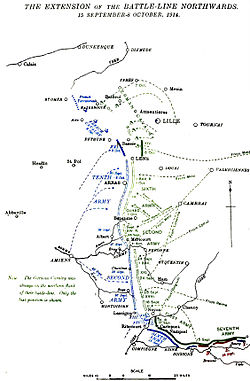
Back السباق نحو البحر Arabic Бег да мора Byelorussian Бег да мора BE-X-OLD Cursa cap al mar Catalan Wettlauf zum Meer German Carrera al mar Spanish Itsasorako Lasterketa Basque Kilpajuoksu Atlantille Finnish Course à la mer French Carreira cara ao mar Galician
| Race to the Sea | |||||||
|---|---|---|---|---|---|---|---|
| Part of the Western Front of the First World War | |||||||
 Franco-German flanking moves, 15 September – 8 October 1914 | |||||||
| |||||||
| Belligerents | |||||||
|
|
| ||||||
| Commanders and leaders | |||||||
|
Albert I Joseph Joffre John French | Erich von Falkenhayn | ||||||
The Race to the Sea (French: Course à la mer; German: Wettlauf zum Meer, Dutch: Race naar de Zee) took place from about 17 September – 19 October 1914 during the First World War, after the Battle of the Frontiers (7 August – 13 September) and the German advance into France. The invasion had been stopped at the First Battle of the Marne (5–12 September) and was followed by the First Battle of the Aisne (13–28 September), a Franco-British counter-offensive.[a] The term describes reciprocal attempts by the Franco-British and German armies to envelop the northern flank of the opposing army through the provinces of Picardy, Artois and Flanders, rather than an attempt to advance northwards to the sea. The "race" ended on the North Sea coast of Belgium around 19 October, when the last open area from Diksmuide to the North Sea was occupied by Belgian troops who had retreated after the Siege of Antwerp (28 September – 10 October). The outflanking attempts had resulted in a number of encounter battles but neither side was able to gain a decisive victory.[b]
After the opposing forces had reached the North Sea, both tried to conduct offensives leading to the mutually costly and indecisive Battle of the Yser from 16 October to 2 November and the First Battle of Ypres from 19 October to 22 November. After mid-November, local operations were carried out by both sides and preparations were made to take the offensive in the spring of 1915. Erich von Falkenhayn, Chief of the German General Staff (Oberste Heeresleitung OHL) since 14 September, concluded that a decisive victory could not be achieved on the Western Front and that it was equally unlikely in the east. Falkenhayn abandoned Vernichtungsstrategie (strategy of annihilation) and attempted to create the conditions for peace with one of Germany's enemies, by Ermattungsstrategie (strategy of exhaustion), to enable Germany to concentrate its resources decisively to defeat the remaining opponents.
Over the winter lull, the French army established the theoretical basis of offensive trench warfare, originating many of the methods which became standard for the rest of the war. Infiltration tactics, in which dispersed formations of infantry were followed by nettoyeurs de tranchée (trench cleaners), to capture by-passed strong points were promulgated. Artillery observation from aircraft and creeping barrages, were first used systematically in the Second Battle of Artois from 9 May to 18 June 1915. Falkenhayn issued memoranda on 7 and 25 January 1915, to govern defensive battle on the Western Front, in which the existing front line was to be fortified and to be held indefinitely with small numbers of troops, to enable more divisions to be sent to the Eastern Front. New defences were to be built behind the front line to contain a breakthrough until the position was restored by counter-attacks. The Westheer began the huge task of building field fortifications, which were not complete until the autumn of 1915.
- ^ Edmonds 1925, pp. 27–100.
- ^ Edmonds 1926, pp. 400–408.
- ^ Mertz von Quirnheim 1929, p. 14.
- ^ Strachan 2001, pp. 266–273.
- ^ Clayton 2003, p. 59.
- ^ Doughty 2005, p. 98.
- ^ Foley 2007, pp. 101–102.
- ^ Sheldon 2010, p. x.
Cite error: There are <ref group=lower-alpha> tags or {{efn}} templates on this page, but the references will not show without a {{reflist|group=lower-alpha}} template or {{notelist}} template (see the help page).
© MMXXIII Rich X Search. We shall prevail. All rights reserved. Rich X Search